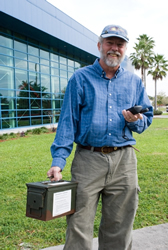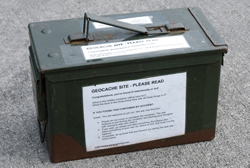 |
Bill Young with the "treasure" and
a GPS unit which is used to locate it.
(Photo: Nick Waters) |
If you see some of the Florida Solar Energy Center’s visitors
rummaging through the landscaping rather than checking out the solar
panel displays, don’t be alarmed – they are just searching
for treasure. Unfortunately there is no chest full of legendary gold
buried on site, but for these treasure-hunters, called geocachers,
the fun is in the chase. Geocachers use hand-held global positioning
systems (GPS) and latitude/longitude coordinates to locate prizes
all over the world.
This treasure-hunting phenomenon began in 2000, in Portland, OR,
when a GPS enthusiast wanted to test the accuracy of his new GPS unit.
After hiding a bucket in the woods and noting the item’s latitude
and longitude, he posted the coordinates online at a GPS user forum.
Within three days, two different forum readers had found the item
and others began hiding their own stashes. After that, the concept
spread through Internet communities like wildfire.
Eight years later, we have our very own cache here at FSEC. Hidden
by Bill Young, senior solar energy research engineer and a geocacher
himself, the FSEC cache coordinates were listed in late July 2007.
Since then, about 40 geocachers have stopped by and
located the loot,
coming from as far as Wisconsin and Connecticut. Inside the
lockbox, geocachers can find solar beads, pencils made with recycled
money, FSEC information and brochures, and a log book to sign in.
Visitors are encouraged to take a look around the center, come inside
and learn a little more about the facility and developments in solar
energy research.
 |
Geocache before it was buried.
(Photo: Nick Waters) |
The demographics of geocachers are very diverse, with participants
ranging in age from middle-school students to senior citizens, and
coming from all over the country. This presents a great opportunity
to generate solar energy awareness among a wide variety of people
while they are simply participating in a personal hobby.
“By setting up a cache here, we’re not just informing
people about FSEC and what we do,” Young said. “They’re
here, they’ve been walking around the site, and now they’re
interested.”
